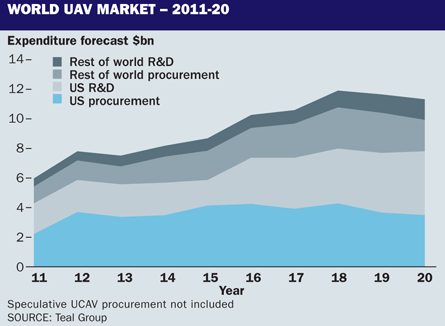While few would dispute that unmanned air systems have transformed military aviation during the past decade, it is looking increasingly certain that the coming 10 years will see huge change in unmanned air vehicles themselves. It would not be excessive to call the next couple of years a genuine watershed in the development of UAVs.
Steven Zaloga, co-author of a Teal Group study of the sector, likens the current generation of UAVs to the aircraft, tanks and artillery of the First World War. These technologies proved critical but were not mature, and it was during the years after the war that they were more fully developed. The first drone aircraft, he notes, appeared in 1917, but it was not until the past decade that a "cascade of technologies" such as GPS navigation and datalinks combined with the post 9/11 military need for surveillance in Afghanistan and Iraq to spur development and mass deployment of a mature generation of UAVs.
 |
|---|
As in the years after 1918, Zaloga foresees development of a new generation of platforms as combat in Iraq and Afghanistan winds down. While current-generation UAVs were largely developed from existing platforms rather than through competitive tendering, the next generation are going to be developed to meet specific requirements and thus promise to be much more sophisticated, he says.
GETTING HOSTILE
Next-generation UAVs will be designed to survive in much more hostile environments, for missions against enemies possessing effective anti-aircraft defences, and for deployment beyond the intelligence, surveillance and reconnaissance missions typical of today's UAVs. Some of these programmes will thus be expensive. Zaloga expects the big defence contractors to make a serious play for them. He says: "They are very anxious to get involved in the UAV field."
But big names in defence are not necessarily destined to succeed. Winners, says Zaloga, will be the companies that best understand the armed services' requirements and master the integration of electronic systems to meet them, with a clear appreciation of the fact that the "aircraft is just a platform".
He expects further surprises in the player line-up. Just as General Atomics and Sagem were not thought of as airframers before rising to UAV sector prominence with their Predator and Sperwer, and mini-UAV leader AeroVironment was a newcomer to military aviation, the next generation of UAVs are just as likely to come from new names as from established airframers.
In the years to 2020, the Teal Group expects US spending in UAVs to be even more dominant than it is in defence spending overall. As global UAV research, development and procurement spending doubles from current levels (see chart), US UAV R&D spending will account for 77% of the world total, compared with 64% of world defence R&D. In UAV procurement, the USA will spend 69% of the total, versus 38% of defence procurement.
US dominance will stem from its greater investment in cutting-edge technologies and its head start over other major aerospace centres such as Europe. The trend follows those in other sectors such as guided weapons, information and sensor technology and military space systems.
After the USA, the biggest spending region will be Asia Pacific, closely followed by Europe. Africa and Latin America will be modest spenders.
Some of the most exciting developments are poised to come in UAVs for civil use. With large numbers of UAVs in service, people will find roles for them, says Zaloga. Civil operators such as coastguard services and border patrols will increasingly look to UAVs to meet new requirements or satisfy existing ones.
As airspace issues are resolved, other non-military uses are certain to follow, with rich rewards for companies able to develop new UAVs or adapt existing ones to meet them.
One civil market to watch is Japan, which the Teal report - written before the Japanese earthquake - sees as a niche market ready for rapid development. Zaloga notes that one example of adaptation of existing, military airframes is the use of a Global Hawks to survey the Fukushima nuclear reactor.
Source: Flight International
















